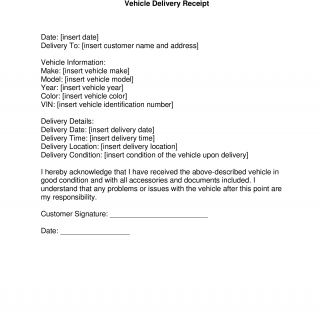Vehicle Delivery Receipt
A vehicle delivery receipt is a standard document used to confirm the successful delivery of a vehicle from a seller or dealer to a customer. It consists of several important fields, including the date of delivery, details of the vehicle being delivered (including make, model, year, color, and VIN), delivery location, and delivery condition.
The purpose of the vehicle delivery receipt is to provide legal proof that the vehicle was delivered in good condition and with all accessories and documents included. The receipt serves as a record for both the customer and the seller, and helps to prevent disputes over the condition of the vehicle at the time of delivery.
When filling out the form, it is important to ensure that all information is accurate and complete. The customer should carefully inspect the vehicle upon delivery and note any damage or issues on the receipt.
In addition to the delivery receipt, the customer may be required to provide additional documents, such as proof of insurance and a valid driver's license.
This form is commonly used by dealerships, rental car companies, and private sellers. It is important for both parties to keep a copy of the receipt for their records.
Strengths of the vehicle delivery receipt include its ability to provide legal proof of delivery and prevent disputes between buyers and sellers. A weakness could be that some customers may overlook certain details when inspecting the vehicle upon delivery.
Alternative forms or analogues may include other types of delivery receipts, such as those used for furniture or appliances. However, these forms would not include the specific details required for a vehicle delivery.
Overall, the vehicle delivery receipt is an important document that protects both the customer and the seller during the delivery process. It should be filled out accurately and completely, and kept as a record for future reference.

